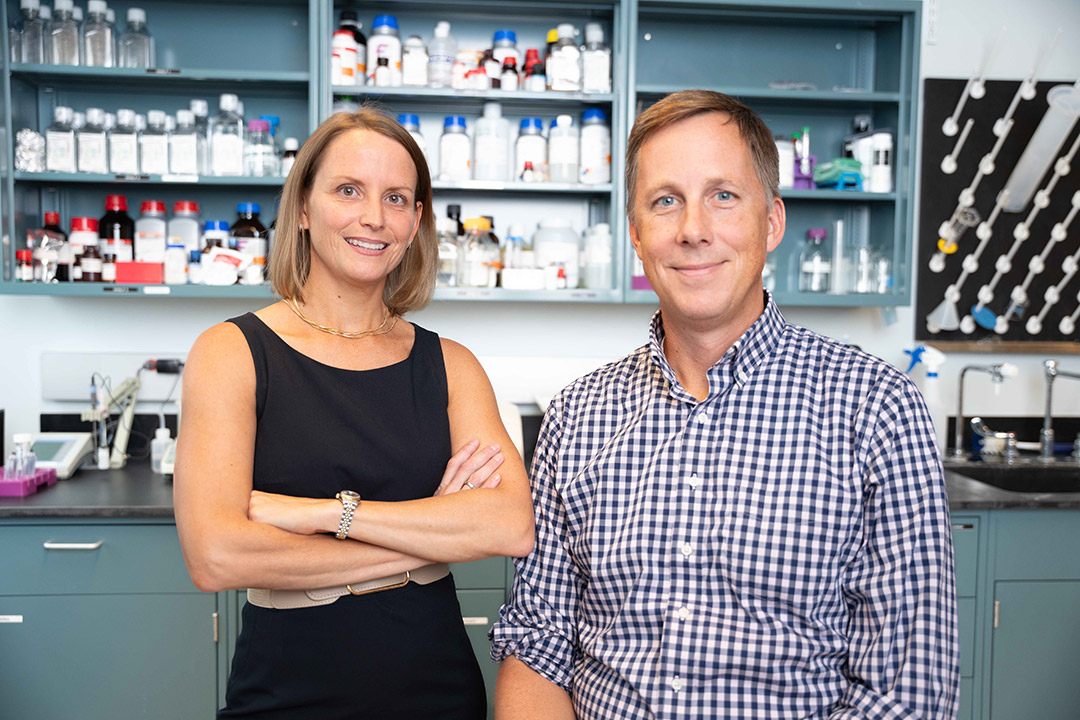RIT researchers pioneer solutions for degenerative disc disease and back pain
Non-invasive approach involves the use of extracellular vesicles and CRISPR gene-editing to advance regenerative medicine
Travis LaCoss/RIT
Karin Wuertz-Kozak and Thomas Gaborski, both professors of biomedical engineering, are collaborating on a project using gene-editing technologies to improve degenerative disc disease.
Rochester Institute of Technology researchers are improving non-invasive treatment options for degenerative disc disease, an ailment that impacts 3 million adults yearly in the U.S., according to the Mayo Clinic.
Using state-of-the-art gene editing technology in mesenchymal stem cells, the researchers will add to the growing field of regenerative medicine, the process of producing cellular therapies to alleviate pain and lack of mobility.
Karin Wuertz-Kozak and Thomas Gaborski, faculty-researchers in RIT’s Kate Gleason College of Engineering, recently received a National Institutes of Health award for “Extracellular vesicles produced by CRISPR-activated mesenchymal stem cells: A potential therapy for degenerative disc disease.” The two-year, $420,040 award, which includes an in vitro feasibility study, begins this month.
CRISPR technology offers a precise method for genome editing, enabling the modification—knockout or activation—of a single gene or multiple genes within cells. Extracellular vesicles (EVs) are lipid nanoparticles that function as important mediators of intercellular communication by carrying biological cargo, including proteins, lipids, and nucleic acids.
“We envisioned the potential of CRISPR-modified stem cells producing EVs with a therapeutically more beneficial cargo,” said Wuertz-Kozak, a professor of biomedical engineering.
The researchers are targeting TSG6, a critical stem cell marker known to be linked with the regenerative and anti-inflammatory properties of these stem cells.
“Our hypothesis is that if we CRISPR-activate TSG6 in stem cells, we will not only increase TSG6 protein levels in the EV cargo, but we could potentially amplify the overall regenerative capacity of extracellular vesicles,” Wuertz-Kozak explained. She is an expert in regenerative medicine, with a focus on inflammation, and the development of novel treatment options that allow for tissue regeneration and pain reduction. Gaborski, a professor of biomedical engineering and an expert in materials engineering, biological separations, and cellular barrier models, has been instrumental in the development of nanomembranes that can be used to capture extracellular vesicles. He will contribute his expertise to enhance the size-dependent isolation of the EVs produced by the CRISPR-modified stem cells.
Stem cell therapy has been a viable area in regenerative technologies for numerous pathologies over the past several years. However, the degenerated intervertebral disc is a harsh environment that impairs stem cell survival, resulting in limited clinical success of stem cell therapy for the disc. Past research showed that EVs from stem cells contain many therapeutically beneficial proteins, lipids, and nucleic acids and carry much of the regenerative potential of stem cells. Once thought of as unused cast off from cells, the use of EVs is now viewed as a potential alternative to cell therapy, avoiding the challenges associated with stem cell survival upon injection.
Both researchers have previously worked together on related topics. In 2022, the two received an NSF grant to develop processes to biomanufacture CRISPR-edited stem cells capable of differentiation and able to enhance development and improve their isolation and purification.
“The size of extracellular vesicles may determine their therapeutic potential,” said Gaborski, who developed a nanomembrane technology that will allow the team to collect and test various EV sizes to determine which size-fraction is most beneficial in treating degenerative disc disease.
In the cell culture lab, intervertebral disc cells isolated from surgically removed disc tissue will be treated with these EVs to determine their therapeutic effect in vitro. The team has partnered with the University of Rochester for tissue samples and clinical input.
“The unique synergy between Tom and me drives this research. Although we are certainly not the only ones working on topics such as EVs, membranes, or CRISPR, our diverse and complimentary expertise allows us to combine these areas in a distinctive way,” said Wuertz-Kozak. “While our primary emphasis is degenerative disc disease, the framework we are establishing has broad applicability. We believe that EVs from CRISPR-modified stem cells hold the potential for addressing other degenerative and inflammatory ailments, ranging from osteoarthritis to skin inflammation. The implications of this work are remarkably extensive.”











